Topics
Historiography : Development in the West
History : Applied History
Working of the Constitution
Historiography : Indian Tradition
The Electoral Process
Political Science : Working of the Indian Constitution
Applied History
Political Parties
History of Indian Arts
- What is ‘Art’?
- Indian Traditions of Visual Arts (Drik Kala): Painting
- Prehistoric Paintings
- Mural Paintings and Cave Painting
- Folk Styles of Paintings
- Classical Styles of Painting
- Miniature Paintings in Manuscripts
- Modern Indian Paintings
- Indian Traditions of Visual Arts (Drik Kala): Sculpture Art
- Indus Civilization Sculpture
- Folk Styles of Sculptural Art
- Classical Styles of Sculptural Art
- Indian Iconography
- Indian Traditions of Visual Arts (Drik Kala): Architecture and Sculpture
- Rock-cut Architecture
- Temple Architecture
- Indo-Islamic Architecture
- Indo-Gothic architecture
- Indian Traditions of Performing Arts
- Indian Theatre
- Indian Music
- Indian Dance
- Present Scenario of the Performing Arts
- Art, Applied Art, and Professional Opportunities
Social and Political Movements
- Movement
- Important Movements in India
- Tribal Movement
- Farmers Movement
- Worker's Movements
- Women’s Movement
- Environment Movements
- Consumer Movement
Mass Media and History
Challenges Faced by Indian Democracy
Entertainment and History
Sports and History
Tourism and History
Heritage Management
History - Imperialism
History - 20th Century Age of conflict
History - Emancipation of Asia and Africa
History - World after World War 2
Political Science
Geographical discoveries and colonization
- Concept for Geographical Discoveries and Colonization
Africa
- Imperialism - Africa
Asia: India, China, Japan
- Concept for Asia: India, China, Japan
Dictatorships in Europe, Second World War and world
- Concept on Dictatorships in Europe
- Concept for Second World War and World
First world war
- Concept on First World War
The League of Nations
- Concept for the League of Nations
Russian Revolution
- Concept for Russian Revolution
United Nations Organization
- Concept for United Nations Organization
Africa
- Emancipation of Africa
Asia
- Emancipation of Asia
Globalization
- Globalization After World War II
Scientific and Technological Progress
- Scientific and Technological Progress After World War II
Cold war
- Formation of the Cold War
Social Diversity and Democracy
- Social Diversity
- Coccept for Caste/Race and Democracy
- Concept for Language and Democracy
- Cocnept for Religion and Democracy
- Concept for Gender and Democracy
- Concept for Democracy and Diversity
Challenges to Democracy Remedial Measures to the Challenges
- Concept for Challenges to Democracy Remedial Measures to the Challenges
Internal work
Democracy
- Democracy - Meaning, Types and Characteristics
Political Parties and Types
- Political Parties
- Importance of Political Parties
- Major National and Regional Parties in India/ Types of Political Parties
Notes
Classical Style of Sculptural Art:
From abstract images made of stone and terracotta during the Indus Valley Civilization to the complex human figures of the Mauryan period, Indian sculpture has an ancient legacy.
Buddhist Sculpture:
- Sixth century BCE marks the beginning of new religious and social movements in the Gangetic valley in the form of Buddhism and Jainism which were part of the shraman tradition.
- Due to their opposition to the varna and jati systems of the Hindu religion, both religions gained popularity.
- Magadha grew to be a strong kingdom and established its dominance over the other regions. By the third century BCE, a significant portion of India was under Mauryan rule.
- The Mauryas had already cemented their hegemony by the fourth century BCE.
- In the third century BCE, Ashoka, the most powerful ruler of the Mauryan empire, supported the Buddhist shraman tradition.
- From the second century BCE onwards, various rulers established their control over the vast Mauryan Empire: the Shungas, Kanvas, Kushanas, and Guptas in the north and parts of central India; the Satvahanas, Ikshavakus, Abhiras, Vakataks in southern and western India.
- Incidentally, the period of the second century BCE also marked the rise of the main Brahmanical sects such as the Vaishnavas and the Shaivas. There are numerous sites dating back to the second century BCE in India.
- Some of the prominent examples of the finest sculpture are found at Vidisha, Bharhut (Madhya Pradesh), Bodhgaya (Bihar), Jaggayyapeta (Andhra Pradesh), Mathura (Uttar Pradesh), Khandagiri-Udaigiri (Odisha), Bhaja near Pune and Pavani near Nagpur (Maharashtra).
1. Mauryan dynasty during Ashoka:
- The tradition of carving out rock-cut sculptures of larger size began in the Mauryan period in emperor Ashoka’s time.
- The lion capital of the Asokan pillar found at Sarnath is the national emblem of India. It is carved with considerable care - voluminous roaring lion figures firmly standing on a circular abacus which is carved with the figures of a horse, a bull, a lion, and an elephant in vigorous movement. This pillar capital symbolising Dhammachakrapravartana has become a standard symbol of this great historical event in the life of the Buddha.
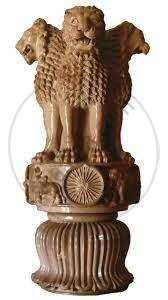
Asokan pillar, Sarnath
- Worship of Yakshas and mother-goddesses, Yakshini was prevalent during that time. The life-size standing image of a Yakshini holding a chauri (flywhisk) from Didargunj near modern Patna is another good example of the sculptural tradition of the Mauryan Period.


Didargunj Yakshin, Patna
2. Bharhut sculptures:
- The sculptures here are tall like the images of Yaksha and Yakshini in the Mauryan period.
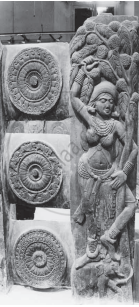
Yakshini, Bharhut
- At Bharhut, narrative reliefs demonstrate how artists skillfully conveyed stories through pictorial language. In one such story, in Queen Mayadevi's (Siddhartha Gautama's mother) dream, for instance, an elephant is seen descending.
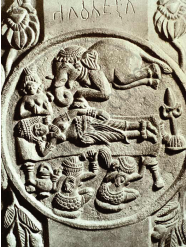
Queen Maya’s dream, Bharhut
- During the early stages of Buddhism, Buddha is symbolically represented by footprints, stupas, a lotus throne, chakra, and so on.
- This can be either basic worship or paying homage, or it might depict the historisisation of life events.

Stupa worship, Bharhut
3. Sanchi Sculptures:
- Sanchi near Bhopal, Madhya Pradesh, is a World Heritage Site.
- The next phase of sculptural development at Sanchi Stupa-1, Mathura, and Vengi in Andhra Pradesh (Guntur District) is noteworthy in the stylistic progression.
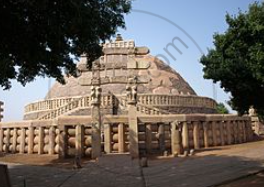
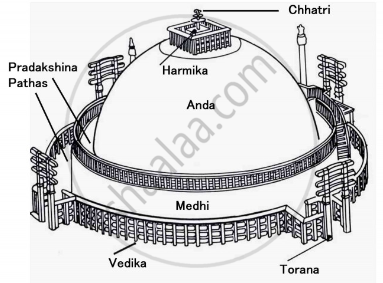
Plan of Stupa-1, Sanchi
- Stupa-1 at Sanchi has upper as well as lower pradakshinapatha or circumambulatory path.
- It has four beautifully decorated toranas depicting various events from the life of the Buddha and the Jatakas.
The stupa at Borobudur in Indonesia is the largest stupa in the world. It was built during the 8th-9th century C.E. It was declared a World Heritage site in 1991.
If you would like to contribute notes or other learning material, please submit them using the button below.
